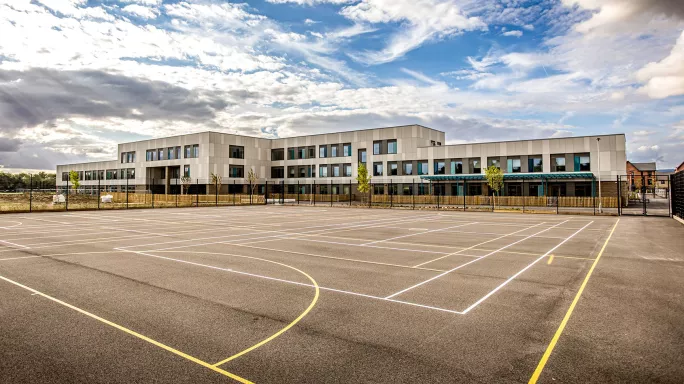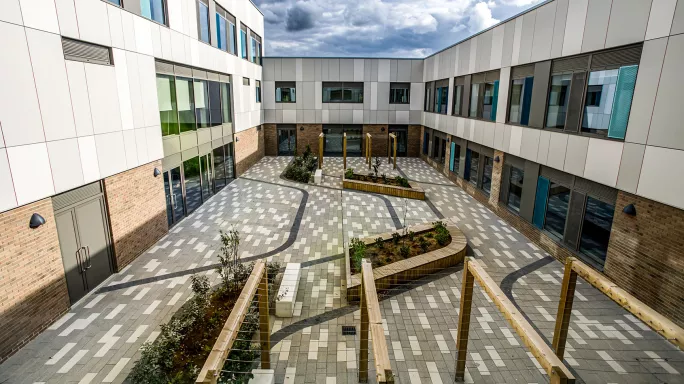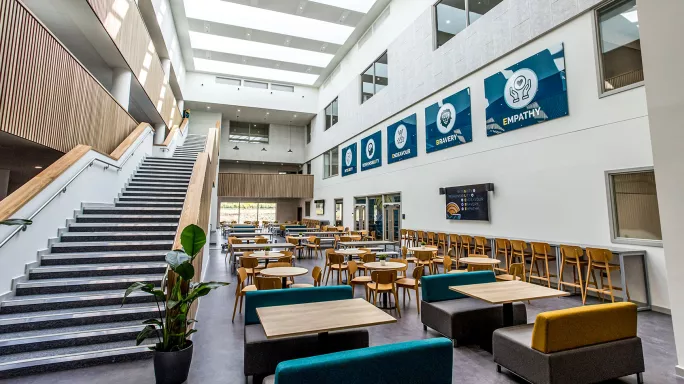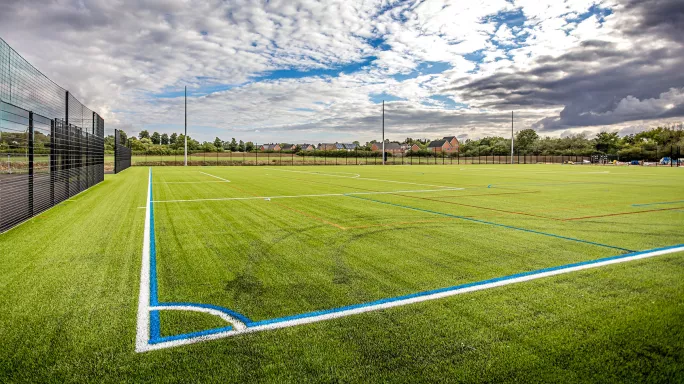The school teaching the sector to go fossil fuel-free

£400 for a Bunsen burner.
That was the price that Sarah Bennett, chief executive of Inspiring Futures Through Learning (IFtL), faced when costing out the idea of building an entirely fossil fuel-free school.
Because, whereas a standard, gas-powered Bunsen burner costs as little as £5, an electric-fired one costs a lot more: “[Electric] Bunsen burners were a revelation - and expensive,” she laughs.
Yet the purchase was signed off because the multi-academy trust was committed to the construction of Glebe Farm School in Milton Keynes delivering on the council’s target of making the city carbon neutral by 2030.
This was no easy feat. As an all-through school from ages 4 to 18 that opened its doors in September, it will in time have more than 1,500 pupils, and that means it will use a lot of energy: in classrooms, offices, kitchens and, of course, science labs.
Yet through close collaboration between the trust, the council and architects, it has been achieved. And the project could well serve as a guide for the sector on how schools can become more energy efficient in line with the government’s recently published sustainability strategy - and potentially save a lot of money, too.
What’s more, with reports that many old school buildings are not fit for purpose and need replacing, and no doubt political parties looking to position themselves as the ones to solve this problem through a sustainability lens, this is something that school staff, MAT leaders and councils should take note of and potentially draw inspiration from.
The school with no fossil fuels
The first question they’d ask would likely be, how do you build a fossil fuel-free school? Well, first of all, you have to find someone who can build such a school - and is committed to the idea, too.
To do that, explains Stephanie Boak, head of professional and governance service at IFtL, the trust ran a mini-competition tendering process through the Pagabo major works framework - a platform for finding contractors for jobs - with input from the council.
“All approvals for the brief went through Milton Keynes City Council’s delegated decision process and followed the council’s procurement rules,” she says.
This process led to the appointment of construction company Morgan Sindall, which stood out in the tendering process because of its ability to explore the potential of how to make the new school as sustainable as possible - rather than making this something to work around.
James Wood, project manager at Morgan Sindall, says: “From the outset, at the design brief, we quite quickly saw there was an opportunity for this to be ground-breaking in terms of being fossil fuel-free.”
This, in itself, was a big challenge. After all, there were no examples of fossil-fuel-free schools, so there was no handy set of blueprints to copy and paste. Wood admits this meant that a lot of the work to design the school was based on what should work, not what definitely would work.
“One of the biggest challenges with all of these new technologies is taking that step into the unknown. You don’t have a great deal of data to prove some of the examples to show to the client,” he says.
“We quite quickly saw there was an opportunity for this to be ground-breaking”
“There’s an element of trust they need to give us. That’s where Glebe [Farm School], as a finished example, will feed back into other schemes.”
Not only this but there was also the small matter of the pandemic to overcome, with the first meeting of the project taking place on Zoom the day after the first lockdown began.
Bennett admits that this felt “really weird” but everyone’s desire to push on showed there was consensus to make the project work - a sentiment echoed by Councillor Zoe Nolan, cabinet member for children and families at Milton Keynes City Council. “When you do a new build you have opportunities that we wouldn’t otherwise have, and we’ve tried to grab them,” she says.
That much is clear, judging by some of the innovations that have ended up in the school.
For example, all the hot water for the school buildings is heated by air-source heat pumps (ASHPs), which absorb heat from the outside air and power the heating and hot water on site.
These pumps are mission-critical: there’s no backup in a fossil fuel-powered grid if they fail. So Boak says it was important to make sure enough were installed: “The ASHP system is set up to provide continued heating and hot water if any of the units fail - we have five systems in total.”
Furthermore, the school has hundreds of solar panels on its roofs to power all of its high-efficiency LED lights and generate additional power for the wider estate.
The thermal transmittance values of the windows, doors and all external structures are optimised to ensure as little heat loss as possible, helping to give the school an air permeability rating of less than three (the lower the score, the better). Current building regulations only require that new developments achieve a rating of five.


Other smaller innovations have also been included to augment the environmental credentials of the setting.
For example, to offset the carbon emissions of the construction work, 840 trees have been planted, donated by the Woodland Trust, on the school grounds.
Cycling and walking to school are encouraged, with the school site designed so that access points align with existing cycling and walking routes. There are also gardens where vegetables will be sown, tended to and harvested by the pupils.
- Strategy: DfE unveils £5.3 million green schools bid
- Climate change and the curriculum: what needs to change?
- Green teaching: six ways to bring climate change to the curriculum
There is even a bike installed on campus that can be peddled to add energy to the school grid.
“The bike is set up in the school so that children can pedal to create energy, so they understand how that energy is developed,” explains headteacher Matthew Shotton.
Shotton says these small-scale elements of the project are no less important - and require the same careful consideration in terms of suppliers.
“When we’re looking at purchasing things for the school, we’re looking at companies that are selling themselves as carbon-neutral so we know that by purchasing their products we’re not going against our ethos,” he explains.
“The bike is set up in the school so that children can pedal to create energy”
This may sound time-consuming but Shotton says that so far it hasn’t caused any delays or barriers to sourcing the products.
In fact, he says most suppliers are on the same journey to becoming a more sustainable business - particularly if they already supply to the public sector.
The school has also attempted to go as paperless as possible by issuing iPads for teachers and pupils, something Shotton says is already having an impact - and not just on green initiatives.
“What we’re already seeing, and what teachers are reporting, is that they’re spending less time doing the menial tasks such as cutting, sticking, prep on a photocopier,” he says.
“They do it once on their iPad, and then they send it out. Marking is taking less time, too, so that’s having a significant impact on their wellbeing. The TAs [teaching assistants] are no longer having to do that sticking and copying, too, so they’re in the moment.”
While all of this has now been achieved, it does not mean it was easy, and those involved admit it took plenty of debate and occasional disagreement. “You’ve obviously got a practical school to run at the end of the day,” says Boak.
She explains that this was a key point they had to keep returning to in order to ensure that the focus on sustainability and eco-innovations did not impede good teaching and learning.
“For us as a trust, we were trying to make sure that it still worked and that none of it was a barrier,” Boak says.
As an example, she explains that while many of the buildings have large windows installed to maximise natural light and heat transfer from the sun, initial proposals had so much glass that teachers raised concerns.
The first was that it could pose a health risk due to concerns about overheating - understandable after record-busting 40°C summer temperatures in England last year.
Another concern was about where furniture would be fitted to allow items to be stored. In the end, a compromise was reached to reduce the window space slightly and use less fixed furniture so storage was maintained without impacting on the overall design.
“Everything was a good discussion and we came out with the best that we could do,” Boak says diplomatically.
The building work itself was not without stumbling blocks either: post-Brexit complications, Covid restrictions, the outbreak of the war in Ukraine, rising energy costs and even the Suez Canal blockage all led to delays.
Heavy price increases were also incurred on materials, and a lack of skilled labour hit progress.


All told, this meant the cost of the project reached £33 million - not an inconsiderable sum. However, Councillor Jennifer Wilson-Marklew says the council is confident the long-term savings will recoup this money back.
“It’s expected to be made up by the big savings to be made on running costs,” she says.
For the school staff, however, the delays meant there was some anxiety about whether they would be able to be on site for the grand September opening.
But Boak says such a risk was factored into the building plans so that even if the entire site wasn’t finished, there would be enough accessible areas for the school to open. “The school worked with Morgan Sindall to ensure early access was available in key areas to allow set-up for the children arriving whilst a small portion of the school continued with some end-of-project snagging works,” she explains.
It was a close-run thing - whiteboards were still being installed in September - but the site was ready for the first day of school and for Shotton and his team, taking custody of the new site was a huge moment. “The school is amazing to work and learn in, and every one of our children and colleagues talks with immense pride about it,” he says.
This sounds uplifting, but the project is about more than just that: it gets to the heart of one of the government’s key sustainability aims.
“Seeing sustainability brought to life in the buildings around them will allow children and young people to gain experiences which will enhance and contextualise their learning,” the Department for Education’s sustainability strategy document outlines.
“What we’ve achieved isn’t unachievable in an existing structure”
To drive this home at Glebe Farm, Shotton says the school has embedded a code of conduct called “The Glebe Way”, which sets out a list of behaviours and responsibilities that it expects all pupils to follow to build on the environmental ethos of the school.
These include environmental and social responsibility, but also pupils taking responsibility for their learning. Each house within the school is named after a current or historical figure felt to reflect that ethos, from Tessa Khan to David Attenborough and Greta Thunberg
These well-known figures were chosen not only for their environmental acumen and influence but also for the broader values that their stories and lives may inspire in Glebe’s young pupils.
As Shotton says: “We are looking to create good people who not only value their education but value the community in which they live.”
What’s more, this ethos is spreading across the trust, with Bennett explaining that IFtL is now discussing how it can move its entire school portfolio towards achieving net zero, including investing in LED lighting and solar panels for every site.
“Just last week I was having a meeting about how we can move to net zero across the board. We have a carbon-neutral roadmap and I really want the children to be involved in that discussion. I really want being in the trust to mean something to the children,” she says.
While what has been achieved at Glebe Farm School may not be replicable in terms of scale and scope at other schools, those involved say there are things that can be adapted to existing sites.
For example, adding solar panels is certainly something any school could consider - although in these cash-strapped times, the long-term savings they offer may not be enough to justify sign-off right now. But in time could end up being a worthwhile investment.
Furthermore, in light of the need to improve insulation - something we’ve all got more used to recently - Wood says the work done to score an air permeability rating of less than three is something that holds just as true for older, draftier Victorian school buildings.
“What we’ve achieved isn’t unachievable in an existing structure [and] the overall strategy can work in any scenario.” Wood claims. “You need to look at the existing air paths that are leaking from the building.”
Overall, the advice of all parties involved for any school commencing a retrofit project is to concentrate on one goal that you want to achieve.
For an older building, that might be fighting against leaky walls to improve energy efficiency or simply working on becoming a 100 per cent recycling school, whatever is most achievable. Then you can move on to the next project.
In all of this Bennett says she hopes the new school demonstrates that education can innovate and adapt for the future, and that it inspires others. “The most important thing is that this conversation is happening, and now we have some costings to be able to compare,” she adds.
Education can not only play its part in reducing our impact on the environment - it can also inspire the next generation to create a sustainable future for all, she says.
“The people that are going to change the way we use energy are the children, and for me they are fundamental.”
Hannah Fearn is a freelance journalist
You need a Tes subscription to read this article
Subscribe now to read this article and get other subscriber-only content:
- Unlimited access to all Tes magazine content
- Exclusive subscriber-only stories
- Award-winning email newsletters
Already a subscriber? Log in
You need a subscription to read this article
Subscribe now to read this article and get other subscriber-only content, including:
- Unlimited access to all Tes magazine content
- Exclusive subscriber-only stories
- Award-winning email newsletters
topics in this article



